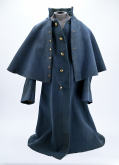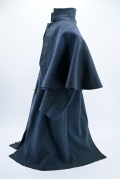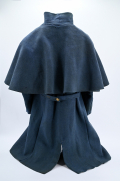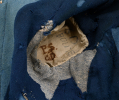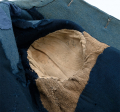site search
online catalog
CAPTURED AND REISSUED UNION OVERCOAT WITH VIRGINIA BUTTONS KEPT BY JAMES KNOX POLK BANTON, 2ND VIRGINIA CAVALRY, PAROLED AT APPOMATTOX: “I HAD CAUTIONED MY MEN AGAINST WEARING ‘YANKEE OVERCOATS,’ . . .” – C.S. MAJ ROBT STILES AT SAYLOR’S CREEK 1865
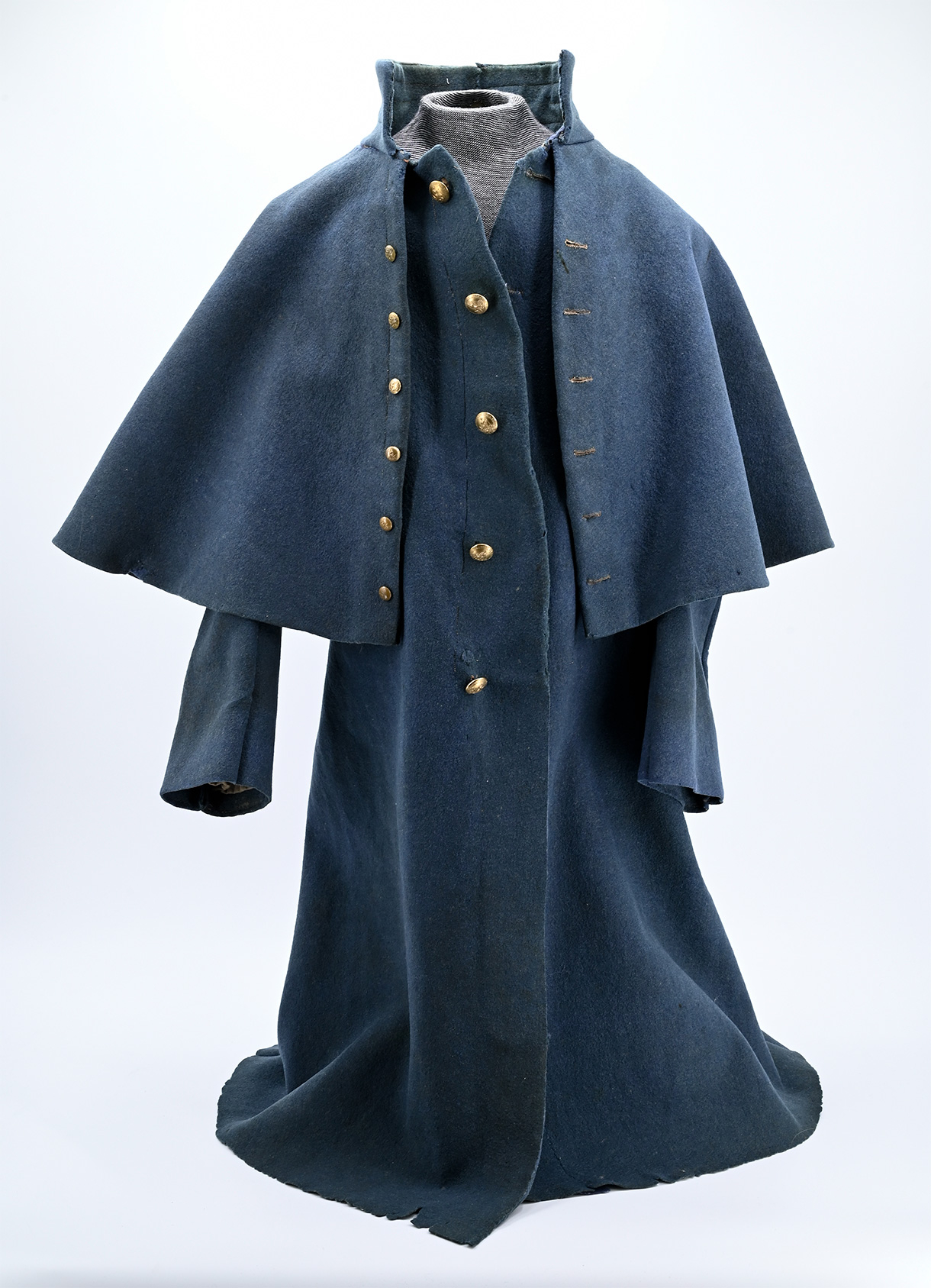
$6,950.00 SOLD
Quantity Available: None
Item Code: 2022-1016
This overcoat follows the general lines of the standard Union enlisted infantry overcoat, but is made of a sky blue heavy felted wool rather than kersey. Overcoats were in such short supply in 1861 that by Fall the Quartermaster General declared he did not care about the color of those supplied, so long as it was not gray, and as states supplying the shortfall for their own troops they might also resort to materials other than kersey. See Troiani, Soldiers in America p.135 for a gray felt state contract example and Mike McAfee’s 2016 article in Military Images for early war variations. Even the commander of the Philadelphia Depot referred to “irregular clothing on hand” in early 1862, directing it be sent to the St. Louis Depot and defining it as, “all black, or blue or grays …. and other woolen fabrics not regulation standard goods.”
The coat is made with a regulation standing collar, tall by comparison with some late war US contract coats, but with the standard six button cape sewn to the base of the collar, and five button body. It does not have the turn-back cuffs of the regulation kersey coat: the sleeve opening showing a simple line of stitching around it. The back of the coat has a short split, as do the standard kersey versions, and a two-piece belt for adjustment with buttons, but the belt is slightly narrower than on late war contracts. The vertical loop at center, through which it passes, is present. The stitching at bottom is gone, but that at top is still secure and holds it in place. The interior of the coat is lined in the body with a dark blue loosely woven sack coat type material like that seen in some Schuylkill Arsenal regulation examples, and the sleeves are lined in white muslin. The skirts are unlined, just like the regulation overcoats.
The coat shows wear and some repairs. There is some abrasion along the rear split of the coat, but no losses. The fabric around a small hole in one armpit has been stitched down. In a couple of places a piece of light blue fabric has been inserted and stitched in place to prevent the edges of a small hole from enlarging. One of these is at the upper back at the base of the collar, a natural point of wear and the inside of the collar just above shows wear, with some stitching added around a tear. None of these is particularly large or obtrusive. The blue lining does show holes, but has been lightly tacked down to prevent further losses. Interestingly, the armpits, almost always the worst hit, seem to have been repaired in the period by the insertion of a loosely woven blanket type material.
The sleeve linings, a dirty white muslin, are present and in good condition. One sleeve shows a faint “3,” a typical army standard sizing, showing the coat is likely a state contract rather than a private purchase piece. One name and a set of initials (repeated) are present: “J. BOUTEN” in large, rubbed, black letters under the number “60,” and “P.S./Co.D” in brown ink just below, and partially visible elsewhere. Bouten may be James Bouten who served as a private in Co. G of the 24th Maine, a nine-month unit, mustering in with them in October 1862 and out with them in August 1863. From January to August 1863 they served in the 19th Army Corps, the Department of the Gulf, taking part in several expeditions and the siege of Port Hudson, but suffering few combat casualties. It seems very unlikely the coat was needed in Louisiana and was likely turned in for reissue, explaining the second set of initials (“P.S.”)
Whoever that owner was, he was seems to have been less lucky: the coat carries a full set of Virginia buttons, indicating it was captured and reissued, and comes from an old Florida collection with an identification to James Knox Polk Banton, who enlisted “for the war” in the 2nd Virginia Cavalry at Verdiersville, Va., mustering into their Company H as a private on 9/25/63. He is listed as being present through April 1864 and then absent wounded in the May-June muster roll and absent through August, but back with the company by 9/15/64 according to CWData, drawing from the VA regimental series, and was with the regiment at Appomattox, where he was paroled on April 9, 1865.
Banton was the son of Sarah and William Banton, an overseer in Campbell County in the 1850 census and a farmer at Appomattox in 1860. Genealogical sources date his birth November 6, 1844, which agrees with the 1850 census, though the 1860 census lists him as 14. By 1870 he had moved to Keysburg, Logan County, Kentucky, and taken up farming. He married in 1871, raised eight children, and died there Feb. 11, 1924.
The 2nd Virginia cavalry was extremely active and served the entire war. Organized in May 1861, it shows well over 400 points at which it suffered losses of some sort in CWData’s tables. Banton’s enlistment in September 1863 puts him in the regiment as it became part of Wickham’s Brigade, Fitzhugh Lee’s Division of the ANV Cavalry Corps. (His enlistment in Company H was natural- the company was nicknamed ‘The Appomattox Rangers” and he presumably knew many of the men.) They saw action at Racoon Ford, Shepherdstown, Jack’s Shop, Stevenburg and Buckland Mills while he was with them in 1863 and in early 1864 they were engaged at Morton’s Ford in the Dahlgren Raid on Richmond. The location of his wounding is not given, but April and May were extremely active as the regiment fought at several locations, including Todd’s Tavern, Yellow Tavern, Spotsylvania, and Haw’s Shop, in the effort to thwart Grant’s Overland Campaign. He would have returned to the regiment while they were serving in the Shenandoah in Fall 1864, fighting at Winchester on Sept. 15, and at Tom’s Brook, Cedar Creek, Mount Jackson, and elsewhere. In early 1865, they foraged their mounts at home, but moved back to the Richmond front in mid-March, fighting at Five Forks, Namozine Church, Amelia Courthouse, High Bridge, Farmville, and Appomattox.
As a felted wool overcoat, this is a scarce item in itself. The material and process making it will be familiar to some collectors from the various “seamless” garments that began appearing in the late 1850s and promised greater protection from water. A few military dealers marketed the military overcoats as “sentinel’s overcoats,” promising new recruits a more comfortable time on outpost duty. They may be familiar as well from issue (albeit in gray) to Berdan Sharpshooters, and the material was in some headgear also, most notably the well-known “Whipple hat,” illustrated in Loane and Langellier’s book on Civil War headgear and elsewhere.
The collector from whom this coat comes did not record the provenance, but all his identifications have so far worked out. Confirmation of Confederate use of captured Union overcoats in the final battles of the war comes from Major Robert Stiles, who recorded the following tragic incident in the melee at Saylor’s Creek, just before Appomattox:
“I had cautioned my men against wearing “Yankee overcoats,” especially in battle, but had not been able to enforce the order perfectly-and almost at my side I saw a young fellow of one of my companies jam the muzzle of his musket against the back of the head of his most intimate friend, clad in a Yankee overcoat, and blow his brains out. I was wedged in between fighting men, only my right arm free. I tried to strike the musket barrel up, but alas, my sword had been broken in the clash and I could not reach it. I well remember the yell of demoniac triumph with which that simple country lad of yesterday clubbed his musket and whirled savagely upon another victim.” [sr] [ph:L]
~~~~~~~~~~~~~~~~~~~~~~~~~~~~~~~~~~~
THIS ITEM, AS WITH ALL OTHER ITEMS AVAILABLE ON OUR WEB SITE,
MAY BE PURCHASED THROUGH OUR LAYAWAY PROGRAM.
CLICK HERE FOR OUR POLICIES AND TERMS.
THANK YOU!
Inquire About CAPTURED AND REISSUED UNION OVERCOAT WITH VIRGINIA BUTTONS KEPT BY JAMES KNOX POLK BANTON, 2ND VIRGINIA CAVALRY, PAROLED AT APPOMATTOX: “I HAD CAUTIONED MY MEN AGAINST WEARING ‘YANKEE OVERCOATS,’ . . .” – C.S. MAJ ROBT STILES AT SAYLOR’S CREEK 1865
For inquiries, please email us at [email protected]
Most Popular
Historical Firearms Stolen From The National Civil War Museum In Harrisburg, Pa »
Theft From Gravesite Of Gen. John Reynolds »
Cavalry Carbine Sling Swivel »
Fine Condition Brass Infantry Bugle Insignia »
featured item
GETTYSBURG SOUVENIR RELIC DESK SET
Made by John Goode. Mounted on a flat wooden plaque measuring 7 x 4 x .875”, with small dark front sticker label: “Gettysburg / July 1863.” The set contains a small, flower decorated inkwell, 1.25 x 1”, with “crystal” stopper-lid. Flanked… (M24195). Learn More »



